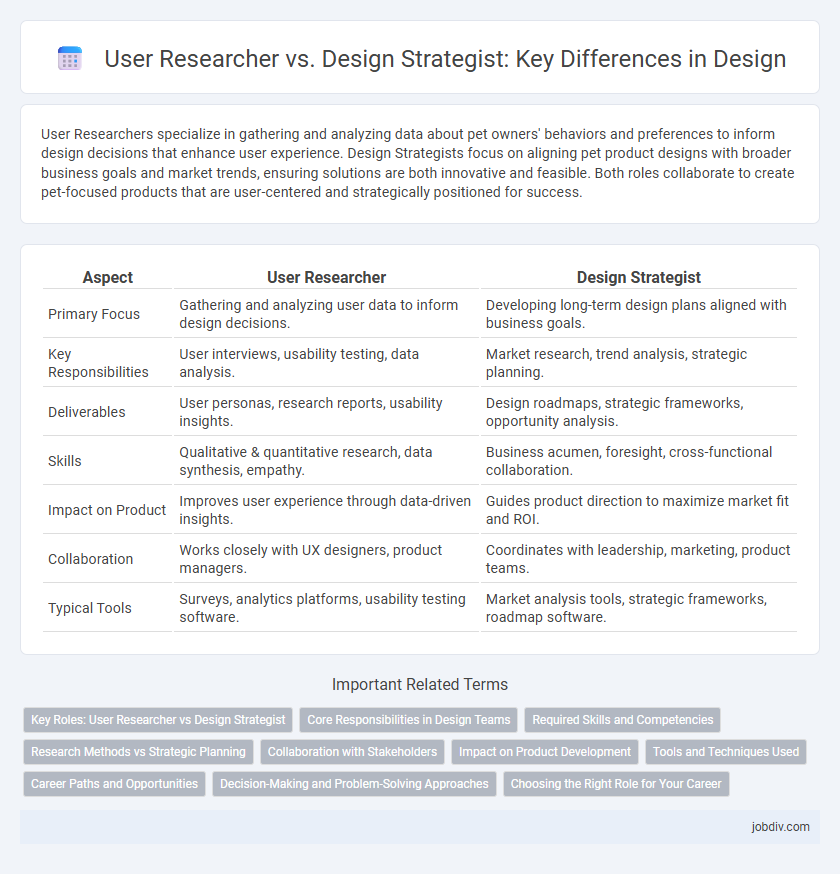User Researchers specialize in gathering and analyzing data about pet owners' behaviors and preferences to inform design decisions that enhance user experience. Design Strategists focus on aligning pet product designs with broader business goals and market trends, ensuring solutions are both innovative and feasible. Both roles collaborate to create pet-focused products that are user-centered and strategically positioned for success.
Table of Comparison
| Aspect | User Researcher | Design Strategist |
|---|---|---|
| Primary Focus | Gathering and analyzing user data to inform design decisions. | Developing long-term design plans aligned with business goals. |
| Key Responsibilities | User interviews, usability testing, data analysis. | Market research, trend analysis, strategic planning. |
| Deliverables | User personas, research reports, usability insights. | Design roadmaps, strategic frameworks, opportunity analysis. |
| Skills | Qualitative & quantitative research, data synthesis, empathy. | Business acumen, foresight, cross-functional collaboration. |
| Impact on Product | Improves user experience through data-driven insights. | Guides product direction to maximize market fit and ROI. |
| Collaboration | Works closely with UX designers, product managers. | Coordinates with leadership, marketing, product teams. |
| Typical Tools | Surveys, analytics platforms, usability testing software. | Market analysis tools, strategic frameworks, roadmap software. |
Key Roles: User Researcher vs Design Strategist
User researchers specialize in gathering and analyzing user data to inform design decisions, employing methods like interviews, surveys, and usability tests. Design strategists focus on aligning design efforts with business goals by developing long-term plans, identifying market opportunities, and creating frameworks for innovation. Both roles collaborate to ensure user-centered designs that drive business value and enhance customer experiences.
Core Responsibilities in Design Teams
User Researchers specialize in gathering qualitative and quantitative data to understand user behaviors, needs, and pain points through methods like interviews, surveys, and usability testing. Design Strategists focus on synthesizing research insights to shape product visions, align business goals, and create strategic roadmaps that guide long-term design decisions. Both roles collaborate closely to ensure user-centered design solutions that meet market demands and drive innovation.
Required Skills and Competencies
User Researchers require advanced skills in qualitative and quantitative research methods, data analysis, and user psychology to gather actionable insights and understand user behaviors. Design Strategists specialize in strategic thinking, market analysis, business acumen, and cross-functional collaboration to align design solutions with organizational goals. Both roles demand strong communication skills, empathy, and the ability to translate complex information into user-centric design improvements.
Research Methods vs Strategic Planning
User Researchers specialize in using qualitative and quantitative research methods such as interviews, surveys, and usability testing to gather insights on user behavior and needs. Design Strategists focus on strategic planning by integrating market trends, business goals, and user insights to develop long-term design frameworks and innovation roadmaps. Effective product development merges rigorous user research with adaptive design strategies to drive user-centered innovation and business success.
Collaboration with Stakeholders
User Researchers collaborate with stakeholders by gathering qualitative and quantitative data to inform design decisions, ensuring user needs align with business goals. Design Strategists engage stakeholders in defining long-term vision and prioritizing design initiatives that drive competitive advantage. Both roles emphasize cross-functional communication to integrate insights and strategy into actionable design solutions.
Impact on Product Development
User Researchers gather qualitative and quantitative data to inform product decisions by understanding user behaviors, needs, and pain points, directly influencing user-centered design improvements. Design Strategists synthesize research insights with business goals to create long-term product roadmaps, aligning design solutions with market trends and competitive landscapes. Both roles drive product development, with User Researchers focusing on data-driven user experience optimization and Design Strategists steering strategic innovation and product differentiation.
Tools and Techniques Used
User Researchers primarily employ qualitative and quantitative tools such as surveys, interviews, usability testing, and analytics platforms to gather user insights and behavioral data. Design Strategists leverage these insights alongside competitive analysis, journey mapping, and scenario planning tools to align design solutions with business goals and market trends. Both roles utilize data visualization and collaboration software, but User Researchers focus on empirical user data while Design Strategists emphasize strategic frameworks and long-term impact.
Career Paths and Opportunities
User Researchers specialize in gathering and analyzing user data to inform design decisions, often working closely with product teams to enhance usability and user experience, which opens career paths in UX research, product design, and human-computer interaction. Design Strategists focus on aligning design projects with business objectives by developing long-term strategies that drive innovation and market growth, creating opportunities in leadership roles, brand management, and innovation consulting. Both roles offer growth in digital product development, but User Researchers emphasize user insights while Design Strategists prioritize strategic vision and business impact.
Decision-Making and Problem-Solving Approaches
User Researchers leverage qualitative and quantitative data to identify user needs, enabling evidence-based decision-making rooted in empathy and usability insights. Design Strategists integrate market trends, business goals, and user research to formulate holistic solutions, prioritizing long-term impact and cross-functional alignment. Both roles apply problem-solving methodologies, but User Researchers focus on uncovering user pain points, while Design Strategists emphasize strategic frameworks for innovation and competitive advantage.
Choosing the Right Role for Your Career
User Researchers specialize in gathering and analyzing user behavior and preferences to inform design decisions, making them essential for user-centered product development. Design Strategists focus on aligning design outcomes with business goals and market trends, driving innovation through strategic planning. Choosing between these roles depends on whether you prefer deep user insights or broader business impact within the design process.
User Researcher vs Design Strategist Infographic

 jobdiv.com
jobdiv.com